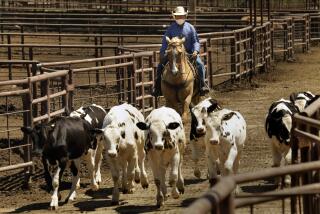Houseboat Heaven: Flush It
Exploring Utah’s Lake Powell several weeks ago, I expected to find a wide, placid reservoir. Instead, a friend and I whipped along in a brisk current flowing between 20-foot-high sand banks. Suddenly, the channel narrowed and the smooth water erupted into 6-foot-high standing waves. Our boat flipped. Flushed downstream in the cold, muddy water, we understood what recent hydrology studies have been indicating: The Colorado River is taking back its canyon.
Lake Powell will soon be no more — at least the Lake Powell that Americans have known for nearly 40 years: the green lake shimmering incongruously in the baking red desert of southern Utah and northern Arizona, a play land for houseboaters created when the federal Bureau of Reclamation shut the gates of the new Glen Canyon Dam in 1963.
Sure, the water could rise 30 feet to 50 feet by the end of next month. But it will drop again by the end of August, and keep falling. No matter what the climate, the drought at Lake Powell will never end. “The Jewel of the Colorado” will never be full again. Much of the time, it will sit nearly empty.
You aren’t likely to hear the responsible government agencies acknowledging this or announcing any contingency plans. But they should. They should concede the inevitable end of Lake Powell, celebrate the return of Glen Canyon and take steps to preserve it for future generations by changing the management of the reservoir and dam.
The facts are clear — and startling. Drought didn’t drain the reservoir, as commonly believed. Rising demand for water did. Simply put, we are taking more water out of the river than nature puts in.
The river has supplied an average of 14.6 million acre-feet of water a year over the 110 years records have been kept. (One acre-foot is enough for two typical southwest U.S. families for one year.) For the first two decades after the dam was completed, states with rights to Colorado River water took just 10.6 million acre-feet a year, which left enough water to fill Lake Powell. Still, that took 18 years, a period that included back-to-back 100-year runoff levels. But over the last two decades, population growth has driven demand to virtually equal supply, with users taking 14.4 million acre-feet a year.
Lake Powell has done exactly what it was supposed to do: It served as a savings account against a dry spell. During the drought, downstream users continued to take their business-as-usual allotment, draining the piggy bank. Now, having been tapped, the piggy can never be replenished because there is no longer a water surplus. Lake Powell was a one-trick pony.
That is true today and will be even truer tomorrow because the Colorado River is over-allocated. There are legal rights to take more water from the river than the river has ever supplied. The holders of those paper rights intend to “develop” them in coming years. Every state has plans for new reservoirs, tunnels and diversions.
The Bureau of Reclamation expects that the four Upper Basin states of Wyoming, Colorado, Utah and New Mexico will increase their take from 4.2 million acre-feet today to 5.4 million in a few decades, and legally they could take as much as 6 million. That adds up to 15 million acre-feet of annual demand on a river that has supplied just 14.6 million over the last 110 years.
How, then, could Lake Powell ever be refilled? Certainly, there will be flood years on the turbulent Colorado, but even if a couple of back-to-back 100-year storm seasons filled the reservoir to capacity, it would be drawn down almost as fast as it filled. What is far more likely is that the West’s climate will grow warmer, leading to less runoff. A recent study in the Journal of Climatic Change predicts 14% to 18% less stream flow in the Colorado basin with just modest warming of a few degrees — robbing the Upper Basin of 2 million acre-feet a year and leaving Powell empty.
To date, the U.S. Department of the Interior and the seven states with rights (including California, Arizona and Nevada in the Lower Basin) have no plan to address the stark new reality. Instead, they apparently intend to act as though one slightly-above-average snow year has saved them from a permanent drought of their own making.
The nation’s largest reservoir, Lake Mead, is downstream from Lake Powell, at the outlet of the Grand Canyon. Under the policy of “equalization” designed to keep the cold peace between the bitter antagonists of the Upper and Lower basins, Lake Mead and Lake Powell will be kept equally full (or empty).
Even the most conservative hydrological assumptions show that the result will be a rump reservoir in Glen Canyon, partly filling, then draining, every year. Even assuming none of the expected increases in demand and temperatures, Lake Powell will be less than half-full more than half the time. If Upper Basin demand increases as expected, it will be less than one-quarter full more than half the time. If the climate also warms, it will empty for practical purposes almost all the time.
Common sense says water managers should fill Lake Mead first. There is enough storage there for all but the biggest flood years, and existing and planned storage elsewhere in the system is more than enough to catch the remainder. If demand rises or the climate warms, even Mead will not be kept full.
From a strictly practical point of view, Lake Mead is a far better place to store water than Powell, where the cracked sandstone of Glen Canyon sucks up water like a sponge and the high desert sun burns it off like a blowtorch. On average, Lake Powell loses 600,000 acre-feet every year — almost as much as the 660,000 acre-feet Los Angeles uses in one year and twice as much as Las Vegas does. Keeping the two reservoirs equalized creates two lake surfaces, not one, and that means losing 70% more to evaporation than would be lost by filling just Mead. In a future of shortages, this waste will be intolerable.
From an aesthetic and ethical point of view, Glen Canyon is among the worst places in America to bury beneath a reservoir.
Its geological spectacle of sinuous red rock canyons is unique in the world. Its quiet rivers, including 200 miles of the Colorado, and 40 miles each of the San Juan and Escalante, form the biological heart of the Colorado Plateau, nursery of the region’s eight unique species, half of them extinct and the other half endangered. Its cultural resources are unparalleled. Thousands of ancient Indian ruins and artworks went underwater after 1963, and many are resurfacing.
After our mishap, my companion and I looked at the remains of Fort Moqui, a stone Anasazi fort perhaps 1,000 years old, now being battered and drowned again by the rising reservoir. Under a ledge we saw ancient petroglyphs, and nearby, chanced on this inscription: “J W Powell 1872,” carved into the rock by the first American to run the Colorado River, Maj. John Wesley Powell.
Though buried by water and mud for 40 years, Glen Canyon and the Colorado River are alive and well. Everywhere, restoration is happening before our eyes. This spring’s runoff is helping clean out the sediment deposits left by the reservoir in the rivers and the 125 smaller side canyons. Willows, cottonwoods and flowers grow. Beavers, otters, birds and native fish are back. The white “bathtub ring,” left on the red sandstone by the reservoir water, which some feared would last 1,000 years, is flaking off like cracked mud, giving the rocks back their colors.
It is Glen Canyon, not Lake Powell, which is returning. The Glen’s 1.25 million acres are already managed by the National Park Service as a National Recreation Area — a status designed to manage power-boating that is no longer sufficient as the flat water disappears. The national treasure of Glen Canyon ought to be preserved for future generations as a national park.
It’s an idea first proposed in the 1930s, and it requires nothing more than a name change by Congress and a recognition by the people of the Southwest that the challenges of the future cannot be met by the answers of the past.
Wade Graham is a trustee of Glen Canyon Institute and editor of the journal Hidden Passage. He has written on environmental issues for the New Yorker, the Los Angeles Times Magazine, Harper’s, Outside and Environmental History.
More to Read
A cure for the common opinion
Get thought-provoking perspectives with our weekly newsletter.
You may occasionally receive promotional content from the Los Angeles Times.






